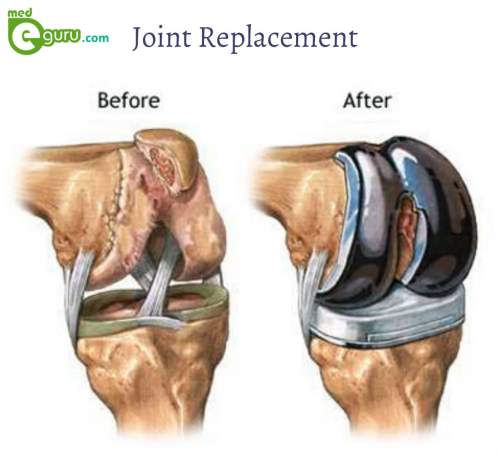What is Joint Replacement Surgery?
Joint replacement surgery refers to removing a damaged joint and placing a new one. Sometimes, the orthopaedic surgeon will not remove the entire joint, but will only replace the parts that are damaged. Joint replacement surgery is an extremely effective method of eliminating chronic pain in the joints, as well as rectifying a deformity and restoring mobility. Joint replacement surgery is generally performed for the treatment of advanced arthritis.
Candidates for joint replacement surgery often experience intense joint pain, stiffness, weakness in the muscles, limitation in motion, and inflammation. The two major causes of joint dysfunction are Osteoarthritis and Rheumatoid arthritis.
The procedure involves resurfacing of the joint that is damaged, and depends on the muscles and ligaments of the patient for support and for ensuring proper function. The prosthesis or replacement joint is often made of titanium, cobalt chrome, stainless steel, ceramic material or polyethylene. It could be either affixed to the bone using acrylic cement or it can be press-fit, which facilitates the growth of the bone into the implant. Once the joint replacement is firmly positioned through surgery, the function and mobility is restored through physical therapy.
Joint replacement is not an ultimate cure for any condition. It can only improve the life of the patient. Knees and hips are the most commonly replaced joints. Shoulders, ankles, elbows and fingers are also replaced. Joints that are damaged due to conditions such as arthritis, injuries or other causes. The new joint which is placed during the surgery is known as a prosthesis. The prosthesis will be made of metal, plastic or using both. The prosthesis is cemented or placed on the joint. The bone will carry and grow into it. Cementing is usually done in older people with weak bones. For younger people, an uncemented one is recommended. It is not recommended to older people as it takes long to heal.
The replaced joint will last for up to 15 years. Joint replacements have become very common these days. Like any other surgery, joint replacement surgery also has negatives and positives and it carries some risks and complications also. It may depend upon overall health of the patient. The doctor will decide whether the patient needs a surgery or not after a thorough checkup. The surgery will be carried out under anesthesia. After that, the damaged joint will be replaced. The surgical procedure differs according to different joints. The severity of the damage also matters.After the surgery, you may have to stay in the hospital for a few days. The durations of the hospital stay will be different for each case. The doctor may prescribe some medicines to ease the pain. You may need help of a physical therapist during the recovery period. The body will heal in a few weeks or so. Any further discomforts should be informed to the doctor immediately.
Major benefits of joint replacement surgery
- Complete relief from pain
- Correction of abnormalities
- Increased range of joint movements
- Stability in the joints
- Improvement in the ability to walk
- Improved quality of life
For a patient who has undergone knee, hip, shoulder or elbow replacement, he has to be in the hospital for about 3 to 5 days. The physiotherapist will recommend certain exercises and will also provide him or her proper gait training using walker, crutches or canes.
Orthopedic Solutions from our Doctors and Hospitals
Joint Replacement Doctors in DelhiJoint Replacement Doctors in ChennaiJoint Replacement Doctors in PuneJoint Replacement Doctors in MumbaiJoint Replacement Doctors in BangaloreJoint Replacement Doctors in KolkataJoint Replacement Doctors in HyderabadJoint Replacement Doctors in AhmedabadJoint Replacement Doctors in SuratJoint Replacement Doctors in Kochi
